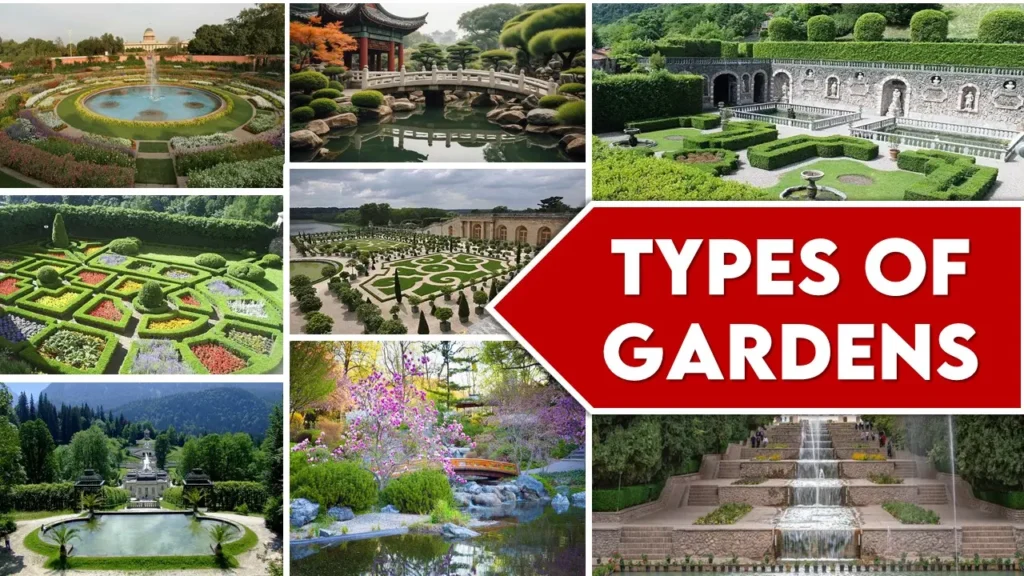Dear gardeners and fellow plant enthusiasts, today we bring to you an important topic that you must know before designing your garden. Today we have come up with the topic: different types of gardens to help you choose what you want.
Everyone desires a beautiful garden; a space that will emblaze your space and a place to nurture and watch every day. You cannot just plant some trees and plants anywhere you like. You need a comprehensive plan that encompasses the list of plants you have and where you want them, you need a design. But what if there is an easy way to design your garden?
People have created some exquisite types of gardens over centuries. You can use these garden types as reference for your personal garden and design one accordingly. So today we discuss the different types of gardens in horticulture so that you can use them as a reference.
Types of Gardens
1. Mughal Garden
The Mughal gardens are one of the types of gardens that require no introduction. They are the symbol of the grandeur and opulence in which the Mughals led their life. They are the prevalent types of gardens in Delhi, Agra, Kashmir, and Lahore. The design is influenced by the Persian Charbagh design and is meant to resemble paradise. The key features include Terraces, Nahars (running water), hill slopes, scented flowers, river banks, high walls surrounding the gardens, and massive entrances. They include the concept of Bardari: canopied structures with 12 open doors, 3 on each side. The examples of Mughal gardens include the Taj Mahal, Humayun’s tomb, Rashtrapati Bhavan, Brindavan Gardens, Agra Fort, Ram Bagh, and Shalimar Gardens.
2. Chinese Garden
Chinese gardens typically contain architecture like buildings or pavilions, decorative rocks, a rock garden, plants, trees, flowers, and water elements like ponds. A wall encloses most Chinese gardens and has winding paths. These gardens are not just thrown together, they are deliberately designed and visitors should walk through them in the particular order that the garden was laid out. The harmony between man and nature is expressed through these idealized miniature landscapes.
3. Dutch Garden
These gardens are known for their formality, geometric design, and efficient use of space. A distinct Dutch feature is the koepel or pavilion, generally built of brick and raised to give a view of the garden. Dutch gardens are typically small due to the densely populated nature of the Netherlands.
4. Egyptian Garden
Egyptian gardens, dating back to ancient times, were a blend of functionality and aesthetics. They began as simple fruit orchards and vegetable gardens, irrigated with water from the Nile. As Egypt became wealthier, these evolved into pleasure gardens with flowers, ponds, and valleys of fruit and shade trees.
A typical Egyptian garden was enclosed by a wall and consisted of three main components: a water pond, well or canal, and types of trees, flowers, and vegetables. The gardens were laid out in a symmetrical, organized fashion.
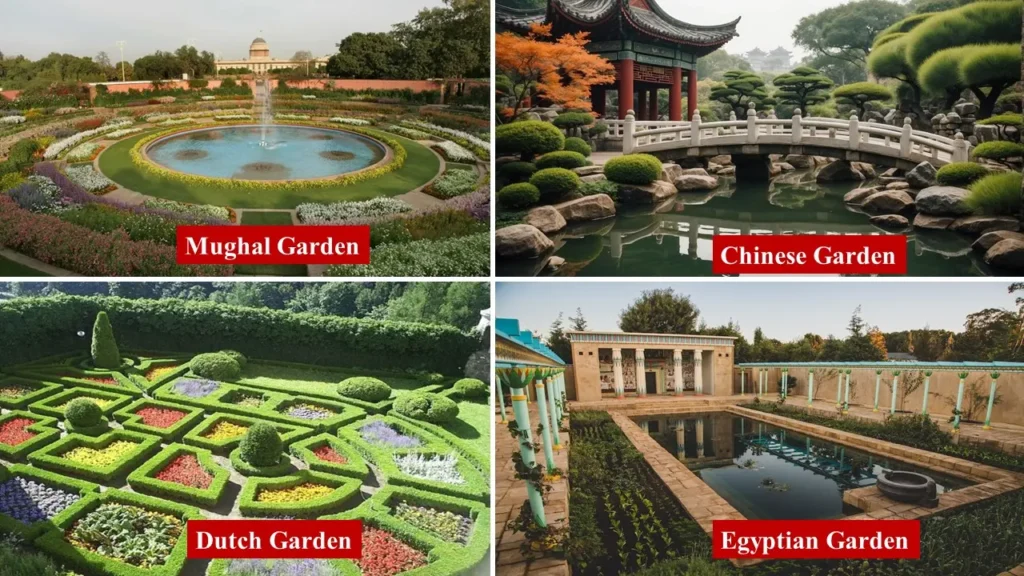
5. English Gardens
English gardens, popularized in the 1800s and 1900s, are known for their large drifts of bright perennials, color themes, a wide variety of textures, and herbaceous borders full of flowers through three seasons. They often include a lake, sweeps of gently rolling lawns set against groves of trees, and recreations of classical temples, Gothic ruins, bridges, and other picturesque architecture. English gardens also feature garden rooms with different functions, connected by pathways typically constructed of brick or stone pavers. Water features such as ponds, streams, waterfalls, rills, fountains, or birdbaths add reflections and the soothing sound of moving water.
6. French Gardens
Inspired by Italian landscape design, French gardens are known for their distinct, symmetrical lines, precisely trimmed hedges and shrubs, simple color palettes, stone elements, and use of lavender. They often have a residence as the focal point, with paths running perpendicular to the structure. In the South, where the climate is Mediterranean, a swimming pool is frequently the centerpiece of a French garden. Maintenance is more demanding in a French-style garden as it’s difficult to hide weeds, unhealthy plants, and garden debris.
7. German Garden
German gardens, influenced by the English garden concept, are known for their emotional aesthetics developed through staffages, embellishments like grottos, and weeping trees. A clear structure characterizes them and often includes domestic animals.
Historically, the style of garden art in Germany in the 20th century is identified with naturgarten, based on the selection of authentic plants for the environmental conditions of each specific location. German gardens are also renowned for hosting all forms of kitsch, including the garden gnome or “Gartenzwerg” in German.
8. Greek Garden
They are framed through Greek culture and are designed to withstand the extremes of the Mediterranean climate. Key elements include stone walls, often whitewashed or painted in light colors, succulents, flowering vines, blue-painted sills, window boxes, and door frames. Terracotta pots filled with herbs and other resilient shrubs are also common.
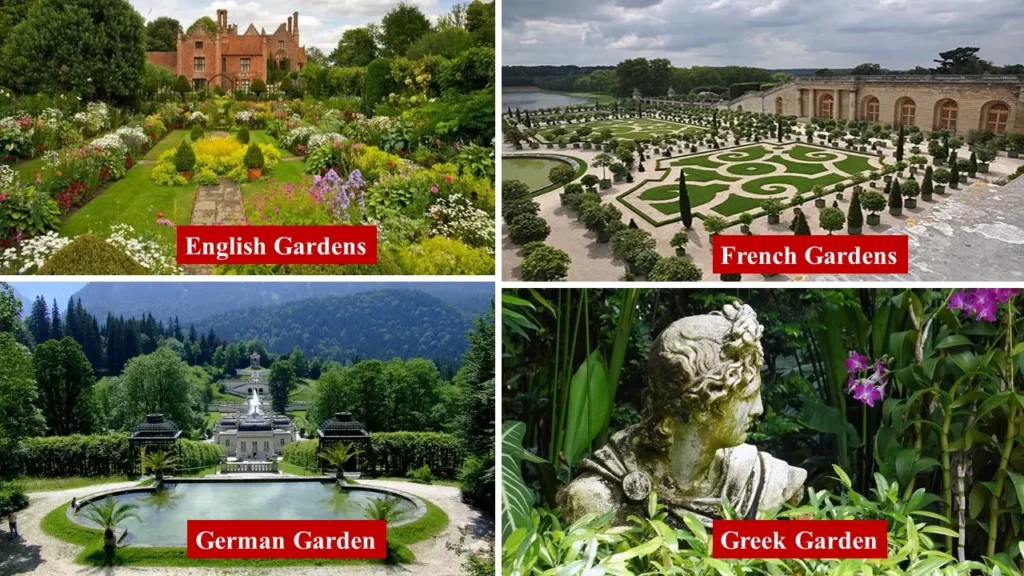
9. Indian Garden
Indian gardens, deeply rooted in history, are a blend of aesthetics and functionality. Walls enclose a typical Indian garden and include elements like ponds, fountains, and canals. Medicinal herbs such as neem, tulsi (holy basil), aloe vera, and turmeric, integral to Ayurveda, are also commonly found. Majestic trees like banyan, peepal (sacred fig), neem, mango, and jamun provide shade, fruit, and habitat for local wildlife.
10. Italian Garden
Italian gardens, perfected in Renaissance Italy, are marked by a heavy reliance on hardscape features, manicured evergreens, scented herbs, and Mediterranean plants. Scented herbs like lavender, rosemary, and tansy complement the visual picture. They often feature mirror-image planting beds on either side of a central walkway or fountain. Water features such as fountains and reflecting pools are common, installed to mitigate excessive warmth and provide shady pergolas. If the property rests on a hillside, the Italian garden would be terraced.
11. Japanese Garden
Japanese gardens often incorporate elements such as the waterfall, with ten or more different arrangements; the spring and stream; the lake; hills, built up from earth excavated for the lake; islands; bridges of many varieties; and the natural guardian stones.
Japanese gardens are generally classified according to the nature of the terrain, either tsuki-yama (“artificial hills”) or hira-niwa (“level ground”), each having particular features. Tsuki-yama consists of hills and ponds, and hira-niwa consists of flat ground designed to represent a valley or moor.
Types of Japanese Garden
Here are the types of Japanese gardens in brief:
- Tea Garden: Prepared for the tea ceremony.
- Dry Landscape Garden: Zen-inspired gravel and rocks. Also known as a Zen garden, it often lacks water elements and uses gravel to represent a dry ocean or river.
- Study Garden: Viewed from the study. It’s designed to be enjoyed from the study, like a painting.
- Strolling Garden: Allows you to walk around a central pond.
- Courtyard Garden: Small and enclosed space.
12. Persian Garden
Persian gardens, dating back to the 6th century BC, are a unique blend of natural and manmade elements. They are always divided into four sectors, symbolizing Eden and the four Zoroastrian elements: sky, earth, water, and plants. The layout follows the Chahar Bagh principle, with plant/flower beds, water supply, management, and circulation systems. They are typically enclosed by high walls and located along a water stream. A central pavilion and a pool of water are common features.
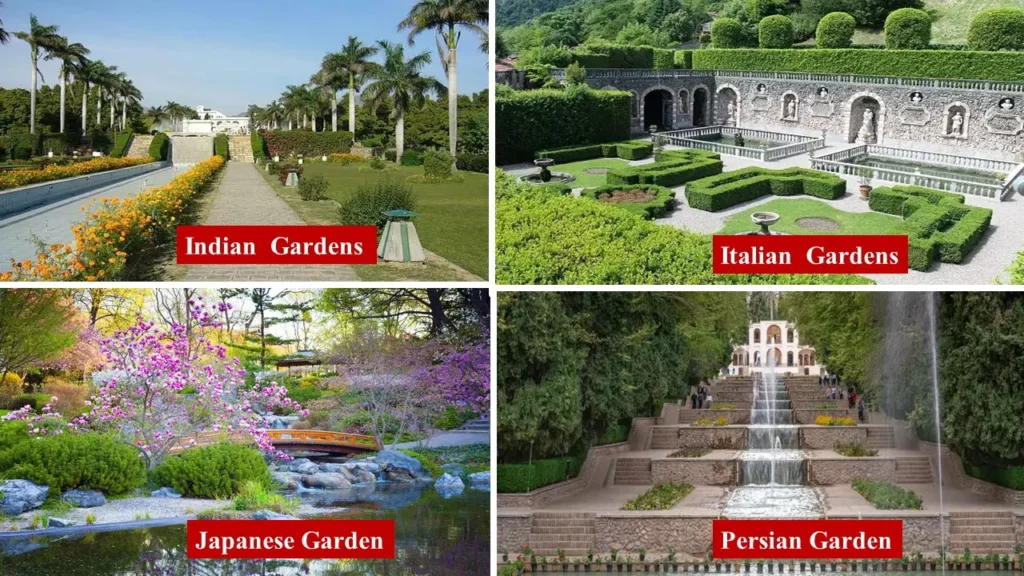
13. Spanish Garden
Spanish gardens, influenced by Roman and Moorish architecture, are known for their distinctive features. They are often symmetrical and divided into sections by pools or water channels. A key element is the paradise garden concept, often depicted with a central cross-axis. Vibrant colors, ornate tiling, and water features are common. Arched doorways and loggias, open corridors facing the garden, are impressive features.
14. Roof Garden
Roof gardens are a blend of natural and architectural elements, often found on flat roof surfaces. They consist of larger planters filled with a mix of evergreens, flowers, shrubs, and grasses. A multilayer system is employed, including a waterproof membrane, drainage layers, geotextile layer, specialized soil medium, soil stabilizer, and a selection of appropriate plant species.
There are three main types of roof gardens:
- Extensive: Low-maintenance, lightweight, thin growing medium of about three to six inches.
- Intensive: Deeper growing medium, hosting a richer ecology, requires professional maintenance.
- Semi-intensive: A mix of both the extensive and intensive types.
15. Vertical Garden
Vertical gardens are an innovative method of growing plants upwards using structures like trellises, wall planters, or stacked containers. The most advanced garden towers offer automatic watering to each plant, integrated light systems, and even integrated nutrient delivery systems.
There are three main types of vertical gardens:
- Green Walls: Vertical structures constructed against flat surfaces, creating a colorful facade.
- Stacked Containers: Tiers of vertically stacked containers that allow plants to be grown above one another.
- Tower Systems: Pre-built units that allow plants to be grown upwards around a central column.
16. Water Garden
Water gardens, also known as aquatic gardens, are a blend of water, flora, and fauna. They often contain submerged plants as the main feature. These gardens can vary in size and depth, but most are typically small and shallow, perhaps less than twenty inches (50 cm) in depth. This is because most aquatic plants are depth-sensitive and require a specific water depth to thrive. Water gardens may include a bog garden for plants that enjoy waterlogged soil. They can house waterfowl, or ornamental fish, in which case it may be called a fish pond.
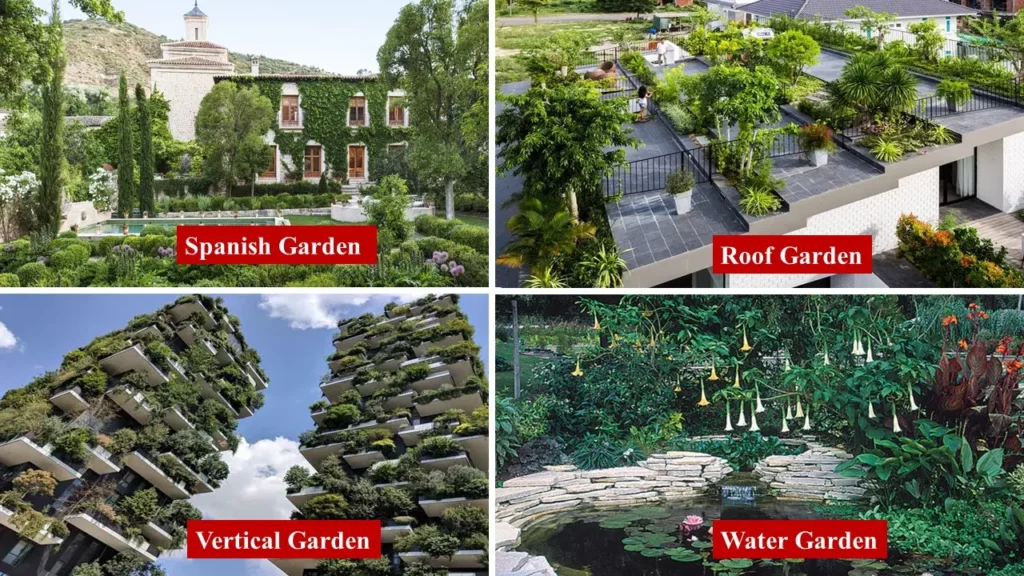
Also Read
17. Rock Garden
Rock gardens, also known as rockeries or alpine gardens, are designed ecosystems that replicate rocky landscapes. Rock garden plants tend to be small, both because many of the species are naturally small, and so as not to cover up the rocks. They can range from complex large-scale projects to simple small corners adorned with gravel and river stones. They are low-maintenance and lend year-round structure to the landscape.
18. Indoor Garden
Indoor gardens are designed for growing plants within enclosed spaces, typically homes. They often incorporate technologies such as built-in LED lights to simulate sunlight, automated watering systems, and nutrient delivery mechanisms. Indoor gardens can be soil-based, allowing for traditional gardening in containers, or hydroponic, where plants are grown in water rather than soil.
19. Tire gardens
Tire gardens are an innovative and sustainable way to repurpose old tires. Tires are deep enough for plants to establish roots. Holes can be drilled in them to promote water drainage. As the tires heat up in the sun, the soil dries faster, keeping the dirt warm and preventing root rot. When space is an issue, a vertically tiered structure maximizes your gardening area.
20. Woodland Gardens
A woodland garden, spanning across an average area of 5,000 square feet, is a tranquil retreat that mimics the natural growth and progression of a forest. the canopy composed of tall trees such as oaks and maples, the understory made up of smaller trees and shrubs, and the ground layer teeming with herbaceous plants. Paths meandering through the garden, covering approximately 500 feet, allow visitors to immerse themselves in this serene, forest-like environment.
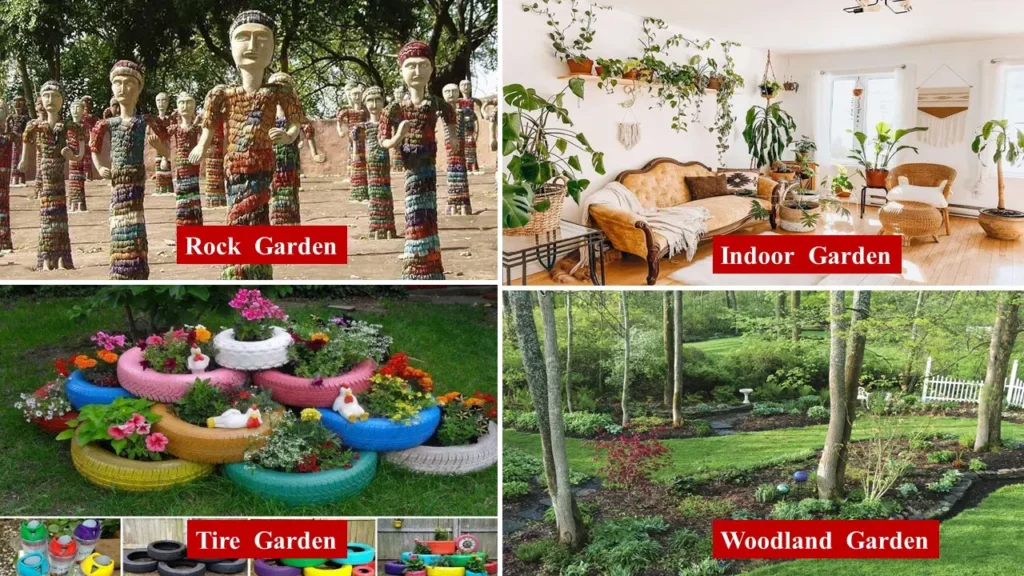
21. Apartment Gardens
An apartment garden, typically spanning 100 to 200 square feet, is a compact green space designed for urban living. The garden is usually arranged in 2 to 3 tiers to maximize space, with hanging plants and vertical gardens being common features. It may also include a small seating area, typically around 20 square feet, for relaxation. With the use of pots and containers, the layout is flexible and can be rearranged according to the seasons or personal preference. Despite its small size, an apartment garden can be a personal oasis amidst the concrete jungle.
22. Xeriscape Gardens
A xeriscape garden, typically spanning 1,000 to 2,000 square feet, is designed for water efficiency. The garden is divided into 3 to 4 hydration zones, grouping plants with similar water needs together. A key feature is the use of a rainwater harvesting system, capable of collecting approximately 500 gallons of water annually. Mulching, another important aspect, uses about 2 to 3 inches of organic material to minimize evaporation. Despite its water-saving design, a xeriscape garden can support about 10 to 15 species of local wildlife, contributing to biodiversity.
23. Zen Gardens
A Zen garden is a minimalist landscape designed for contemplation and meditation. The gravel, raked into precise patterns, symbolizes water, while moss can represent land. A key feature is the Karesansui, or dry landscape, which uses carefully raked gravel to create the illusion of water. The garden often includes a viewing platform from which the entire garden can be seen. Despite its simplicity, a Zen garden can take a considerable amount of time to design and construct, reflecting the careful thought and mindfulness that goes into its creation.
24. Community Gardens
Community gardens are shared spaces where people come together to cultivate plants, typically fruits, vegetables, and flowers. In a community garden, each member is usually allocated a plot where they can grow plants of their choice. The members are responsible for maintaining their plots and often share the harvest among themselves. Some community gardens also donate a portion of their produce to local food banks or other charitable organizations.
FAQs
1. Which type of fertilizer is useful for gardening?
Organic fertilizers, such as compost or manure, are beneficial for gardening because they improve soil structure, promote microbial activity, and provide a slow-release source of nutrients for plants.
2. What are the types of garden plants?
Garden plants can be broadly categorized into ornamental, edible, and medicinal types. Ornamental plants are grown for their aesthetic appeal, while edible plants include vegetables, fruits, and herbs cultivated for consumption. Medicinal plants are those with therapeutic properties often used for health and wellness purposes.
Also Read
Conclusion
Gardens are your spaces for experiencing beauty and tranquility in the vicinity of your home. So, investing our time and energy in making the best garden for your house will be one of your life’s best decisions. In this article, we discussed 24 different types of gardens in horticulture that you can use as a reference while building your garden. You can either follow a single type or can mix various types and make a new type. After all, it’s your garden you can do whatever you like.
Latest Post
- Study Agriculture Abroad : A Complete Guide for USA

- July Issue (2024): Times of Agriculture Magazine

- Why Money Plant is called Money Plant ? Answer in 5 min

- How to grow Monstera from Cutting: 5-Step Detailed Guide

- Latest 10 Finest Terrace Garden Ideas to Transform Your Rooftops

- Top 10 Low Light Hanging Plants to make your Room Crunchy

- Best Water Harvesting Techniques for a Sustainable Future
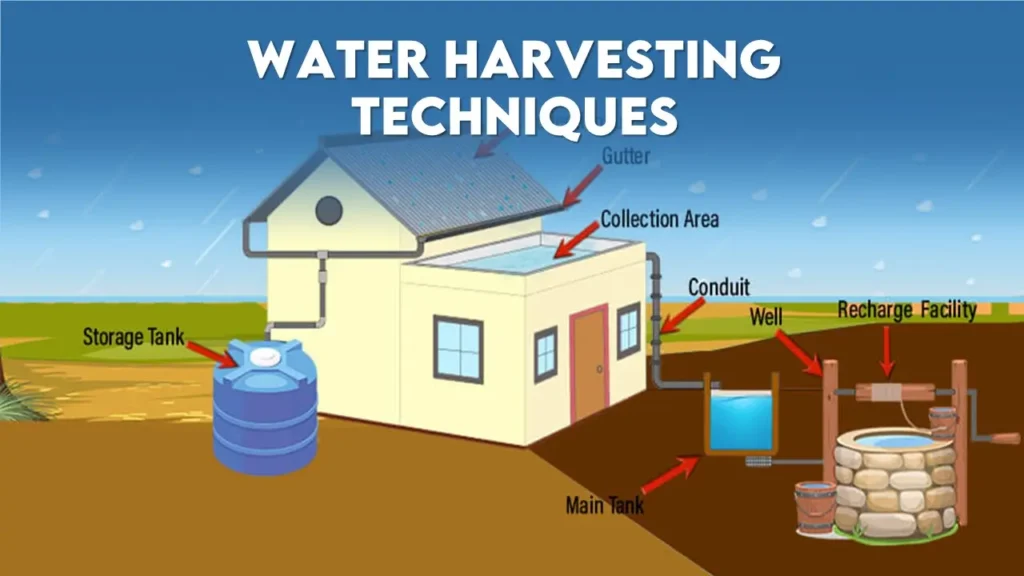
- Low Maintenance Indoor Plants for India: 15 Best plants for home gardening
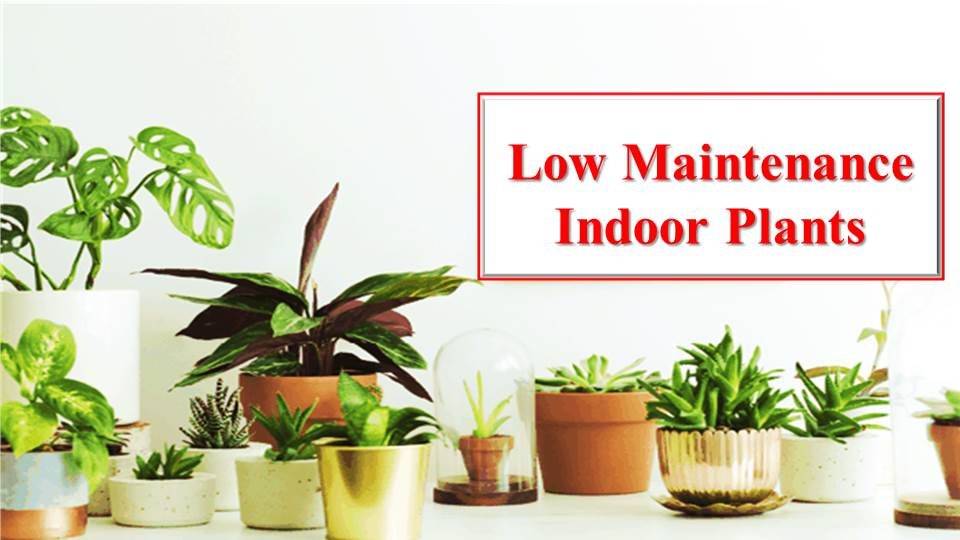
- Top 23 Flowering Trees in India: Flower Tree for Home



